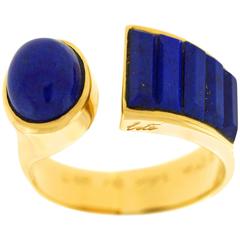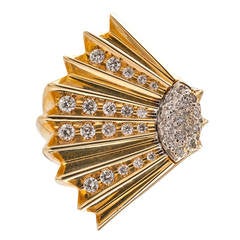Erte Ring
Late 20th Century American Modern Cocktail Rings
Amethyst, Diamond, White Diamond, Gold, 14k Gold, Yellow Gold
Recent Sales
Vintage 1980s American Fashion Rings
Lapis Lazuli, 14k Gold
21st Century and Contemporary American Contemporary Fashion Rings
Vintage 1980s American Art Deco Cocktail Rings
Amethyst, Diamond, 14k Gold
21st Century and Contemporary Cocktail Rings
Amethyst, Diamond, Pearl, Gold, 14k Gold, Yellow Gold
Vintage 1970s French Art Deco Dome Rings
Lapis Lazuli, Pearl, 14k Gold
1990s American Art Deco Cocktail Rings
Diamond, Topaz, 14k Gold
Vintage 1980s American Art Deco Cocktail Rings
Diamond, Topaz, 14k Gold
Vintage 1980s American Cocktail Rings
Diamond, Emerald, 14k Gold
Vintage 1980s American Art Deco Cocktail Rings
Amethyst, Diamond, 14k Gold
Vintage 1980s American Art Deco Cocktail Rings
Amethyst, Diamond, 14k Gold
Vintage 1980s American Art Deco Fashion Rings
Diamond, Emerald, 14k Gold, Yellow Gold
Vintage 1980s American Art Deco Fashion Rings
Amethyst, Diamond, 14k Gold
1990s American Art Deco Cocktail Rings
Diamond, 14k Gold
Late 20th Century Cocktail Rings
Diamond, Ruby, 14k Gold, Yellow Gold, Enamel
Early 2000s American Art Deco More Rings
Diamond, Ruby, 14k Gold
Vintage 1970s American Modern Cocktail Rings
Diamond, White Diamond, Lapis Lazuli, 14k Gold, Rose Gold
Vintage 1970s Fashion Rings
Tiger's Eye, 14k Gold, Yellow Gold
Vintage 1980s Unknown Contemporary More Rings
Lapis Lazuli, 14k Gold, Yellow Gold
People Also Browsed
Mid-20th Century Unknown Modern Cocktail Rings
White Diamond, Diamond, Amethyst, White Gold, 14k Gold, Gold
Erte Ring For Sale on 1stDibs
How Much is a Erte Ring?
Erté for sale on 1stDibs
Born Romain de Tirtoff (1892–1990) in St. Petersburg, Russia, to an aristocratic family, the artist known as Erté — a pseudonym derived from the French pronunciation of his initials — was a Renaissance man of the art and design world. He worked in graphic arts, interior design, fashion, jewelry and set design for the stage and silver screen, becoming a leader of the Art Deco style.
Moving to Paris in 1912, Erté worked as a fashion designer under couturier Paul Poiret before securing a job with Harper’s Bazaar as a cover artist. Over 22 years, Erté created more than 240 magazine covers alongside his ongoing work in fashion design.
Extending his prolific career into theater sets, costumes, prints and lithographs, Erté became one of the most famous artists of the era. His style — a combination of the nature-inspired flourishes of Art Nouveau and bold, geometric linework — directly contributed to the birth of Art Deco, earning him the nickname “the Father of Art Deco.”
After a lull of creative production in the 1940s and 1950s, Erté reentered the public eye in the 1960s, when a renewed interest in Art Deco had taken shape.
Creating colorful lithographs, bold serigraphs (silk-screen prints) and bronze sculptures, he contributed to a resurgence of the style in France and beyond. This late-life acclaim for his art led to exhibitions in museums and galleries all over the world as well as his first published monograph in 1970. That same year he was awarded the title of Chevalier du Mérite Artistique et Cultural and in 1976 was named Officier des Arts et Lettres by the French government.
Today, Erté’s works are in the collections of the Metropolitan Museum of Art and the Cooper Hewitt, Smithsonian Design Museum, in New York, the Victoria and Albert Museum in London and LACMA in Los Angeles.
On 1stDibs, browse a collection of Erté art, including fine art prints, paintings and other works.
Finding the Right Rings for You
Antique and vintage rings have long held a special place in the hearts of fine jewelry lovers all over the world.
No matter their origin or specific characteristics, rings are timeless, versatile accessories. They’ve carried deep meaning since at least the Middle Ages, when diamond rings symbolized strength and other kinds of rings were worn to signify romantic feelings or to denote an affiliation with a religious order. Rings have also forever been emblematic of eternity.
Over time, rings have frequently taken the form of serpents, which have long been associated with eternal life, health and renewal. Italian luxury jewelry house Bulgari has become famous for its widely loved Serpenti motif, for example, and its Serpenti ring, like the other accessories in the collection, began as an homage to jewelry of the Roman and Hellenistic eras. The serpent is now a popular motif in fine jewelry. Jewelry devotees have long pined for rings adorned with reptiles, thanks to antique Victorian rings — well, specifically, Queen Victoria’s illustrious engagement ring, which took the form of a gold snake set with rubies, diamonds and an emerald (her birthstone). Designs for Victorian-era engagement rings often featured repoussé work and chasing, in which patterns are hammered into the metal.
Engagement rings, which are reliably intimidating to shop for, are still widely recognized as symbols of love and commitment. On 1stDibs, a range of buying guides can be found for those in the market for antique engagement rings, vintage engagement rings or Art Deco engagement rings.
The most collectible antique engagement rings and vintage engagement rings are those from the Victorian, Edwardian and Art Deco eras. Named for the monarchies of the four King Georges, who in succession ruled England starting in 1714 (plus King William’s reign), antique Georgian rings, be they engagement rings or otherwise, are also coveted by collectors. Pearls, along with colored gemstones like garnets, rubies and sapphires, were widely used in Georgian jewelry. The late-1700s paste jewelry was a predecessor to what we now call fashion or costume jewelry.
The Art Nouveau movement (1880–1910) brought with it rings inspired by the natural world. Antique Art Nouveau rings might feature depictions of winged insects and fauna as well as women, who were simultaneously eroticized and romanticized, frequently with long flowing hair. Art Deco jewelry, on the other hand, which originated during the 1920s and ’30s, is by and large “white jewelry.” White metals, primarily platinum, were favored over yellow gold in the design of antique Art Deco rings and other accessories as well as geometric motifs, with women drawn to the era’s dazzling cocktail rings in particular.
Whether you’re hunting down a chunky classic for a Prohibition-themed cocktail party or seeking a clean contemporary design to complement your casual ensemble, find an exquisite collection of antique, new and vintage rings on 1stDibs.


